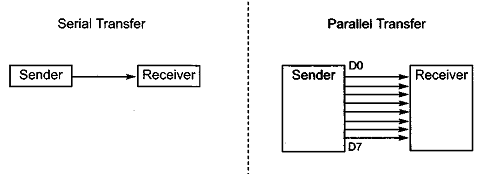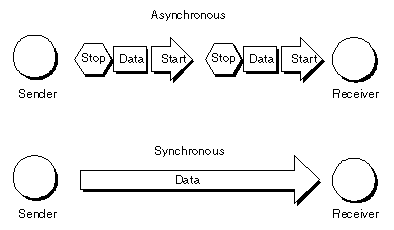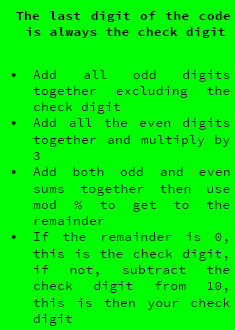New Chapter!
Key words:
- bit
- bit rate
- serial transmission
- parallel transmission
- interference
Different types of data transmission:
- Simplex data transmission– One direction , eg. computer to printer, from the remote control to the TV, radio broadcasting, keyboard to computer
- Half duplex data transmission– Both directions but never at the same time eg. CB radio, and walkie talkie. (unidirectional)
- Full duplex data transmission– Data sent simultaneously in both directions at the same time eg. phone call, WiFi, social networking, multiplayer games, (bidirectional)
Serial Transmission(Slower) – 1 bit at a time in a single stream. Many people often use this method of transmission for long distance transmission as only one wire is used. Data cannot become synchronized using a single cable.
Parallel Transmission(Faster) – several bits of data send over multiple wires. 1 wire per bit is used. Great for short distance communication, if used over long distance data can become skewed.

Serial, half duplex data transmission – unidirectional transmission for long distances. Data can only be sent in one direction at a time. Serial transmission is safer to use for communication. Commonly used in government/military for security.
Parallel,full duplex data transmission – bidirectional transmission for short distances. Parallel data transmission required many wires (1 wire per bit) and is expensive. Data can become skewed over long distances. Could be used within a LAN,server would talk to the computer, computer would talk to the server. Household appliances use this method of transmission also.
Serial, simplex data transmission – one direction transmission for long distances. Works well over a long distance using a single cable. Data can be sent one bit at a time but only in one direction. This method of communication would be used with radio broadcasting.

Parity Checking
Parity checking is an easy/basic method of checking for errors, it helps the computer systems to identify corrupt data patterns. Count the numbers of 1’s, if you want it to be even, you should have the same amount of even numbers and odd, the other way around. You can add either 0’s or 1’s to make it even or odd. However the computer can identify if the sender has even and receiver has odd but not if the numbers are mixed up such as if you send 11001100 and the receiver can get 01101100. Parity Block allows people to know which bit is wrong by looking at it vertically and horizontally.
Checksum:
Another method of data checking is Checksum. Checksum checks to see if data is corrupted, it identifies if the sequence of numbers in the transmission have changed. Blocks of data are transferred, 1 block of data = 1 byte. Maximum size is 255. If numbers are under 255, the checksum will allow the data to pass through without any calculations. If numbers are more than 255 you would need to checksum it (do calculations)
A——B
Here are the steps do checksum:
- Divide the sum, x of the bytes by 256
- Round it to the nearest whole number (y)
- z = y * 256
- Difference (x-z)
- This is the value of your checksum.
Example:
- 266/256
- 1.03 = y = 1
- z = 256
- x = 266
- z = 256
- Answer is 10
ARQ-Automatic Repeat Request
An acknowledgment sent by the receiver indicating data, packet has arrived. If receiver doesn’t notify sender, there is a timeout. Sender will then send the data packet again.
Echo check
Data sent from sender to receiver and back again to check if the data send is the same as what is received. Not a reliable way to check for errors as there is no error checking or trace route being carried out.
Check Digit
Check digit is yet another way of data checking and in my opinion Check digit and Check sum are the most reliable and easy way of data checking. Check Digit is commonly associated with ISBN numbers, vehicle Identification Numbers, Product Codes and Bar codes. Check Digit can identify incorrect digits entered, transposition errors, omitted and extra digits and phonetic errors in speech. You can find the check digit by:

When we say the odd digits I mean the place holder odd digits not the number below.
(1, 3, 5, 7 etc.)

HTTP – HyperText Transfer Protocol
HTTP is the underlying protocol used by the World Wide Web. HTTP defines how messages are formatted and transmitted, and what actions Web servers and browsers should take in response to various commands. For example, when you enter a URL in your browser, this actually sends an HTTP command to the Web server directing it to fetch and transmit the requested Web page.
HTTPS
- A secure version of HTTP
- Indicated by locked padlock icon, https in URL, green address bar
- 3 AIMS
- Confidentiality of communication through encryption
- Authentication of the server (so you know the server is genuine) through SSL certificate issued by Certificate Authority (CA)
- Message integrity (so you know the message has not been tampered with) through message hash